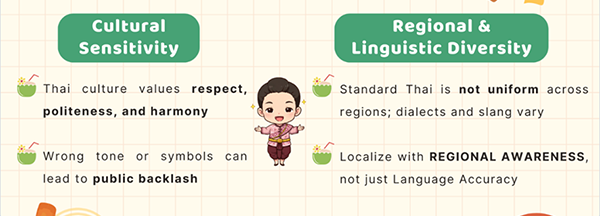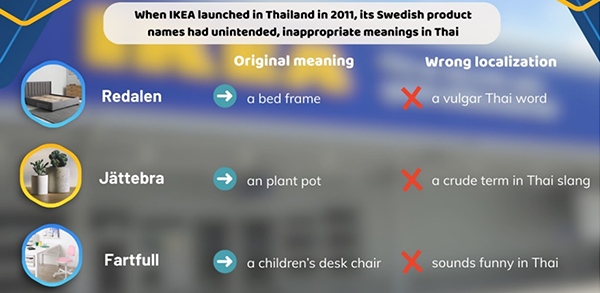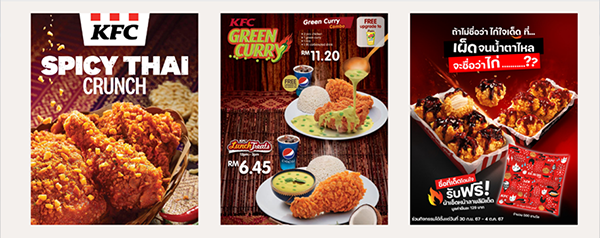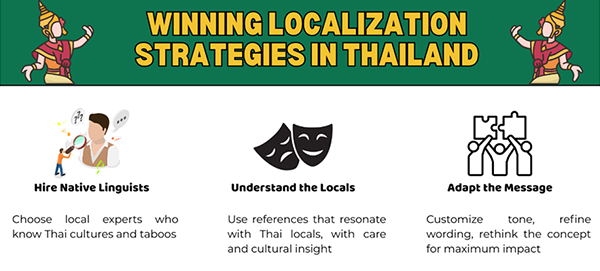list
As Thailand’s digital economy accelerates in 2025, international brands eyeing this vibrant Southeast Asian market must go beyond simple translation, by mastering localization, adapting campaigns to align with Thai culture, consumer behavior, and communication styles.
Scripted by
Nuttharhinie Singhakaew


From family values and social harmony to platform preferences and religious holidays, Thailand’s advertising landscape is both rich and complex. In this article, we will explore some localization challenges and case studies to ensure campaigns that not only resonate with local consumers but also avoid costly cultural missteps.
Thailand has emerged as one of Southeast Asia’s most dynamic marketing destinations, and for good reason. The country boasts a booming digital economy fueled by innovation and a culturally diverse, socially engaged population that actively shapes trends, not just follows them
But here’s the catch: entering the Thai market is not as simple as translating your global campaign and hoping for the best. Thai consumers are savvy, socially aware, and deeply connected to their cultural identity. They expect brands to speak their language, not just linguistically, but emotionally and culturally.
This is where localization becomes a game-changer.
While Thailand offers immense opportunities for global brands, it’s also a market where even small missteps can have outsized consequences. Effective localization is not without its challenges, and brands must navigate several critical obstacles:

Lost in Translation: A Lesson from IKEA
IKEA’s localization misstep in Thailand is a well-known example, often used to highlight the importance of cultural and linguistic adaptation.
When IKEA launched in Thailand in 2011, they used their standard global product naming system — which involves giving products Swedish names. However, some of those Swedish names, when transliterated or read aloud in Thai, had unintended and very inappropriate meanings.

These names, when printed in large fonts in showrooms or catalogs, drew laughter and criticism from local customers and social media users. IKEA then quickly acknowledged the issue and adjusted some of the names in their Thai catalog. Since then, they have become much more cautious in markets where Swedish product names might cause unintended meanings.
The IKEA Thailand case is a classic localization lesson: Just because something works globally doesn’t mean it works locally.
Nailing Localization: KFC in Thailand
KFC is a globally recognized fast-food brand, but to thrive in Thailand’s competitive food market, it needed to go beyond global slogans and tap into local culture. Simply translating its slogan “It’s Finger Lickin’ Good” was not going to cut it — so the brand turned to culturally resonant storytelling and humor.
First, it reimagined the slogan with Thai humor, slang, and social context. Ads featured funny, exaggerated scenarios using familiar archetypes (e.g., aunties, students, quirky office workers), making the content immediately relatable.
Then, KFC introduced menu items tailored for Thai tastes, like Green Curry Chicken Rice and Spicy Waffle, promoted with localized visuals and playful language.
KFC Thailand’s success shows that localization is all about immersing in the culture, understanding what makes the audience laugh, crave, and share — and then crafting campaigns that feel made just for them.

All the above case studies solidify that localization is all about making one brand feel local to consumers and culturally aligned with its targeted market. In Thailand, where culture and communication are deeply intertwined, a successful localization strategy must consider language nuances, visual storytelling, and social context. Here’s how to get it right:

In 2025, success in Thailand’s fast-moving advertising space demands more than creativity — it requires local understanding, cultural intelligence, and expert localization. Want your campaign to truly connect with Thai consumers? Don’t just translate. Transform your message.
At Hansem Global, we specialize in high-impact localization for the Thai market — not only for marketing campaigns, but also for business-critical materials such as user manuals, websites, product brochures, and support content. Our native Thai linguists and technical content experts ensure your message is not only linguistically accurate, but also culturally fluent and functionally clear across every touchpoint.
👉 Whether you’re adapting a slogan or translating 200 pages of documentation, contact us today for a free consultation — and make your brand feel like home in Thailand.
Hansem Global is an ISO Certified and globally recognized language service provider. Since 1990, Hansem Global has been a leading language service company in Asia and helping the world’s top companies to excel in the global marketplace. Thanks to the local production centers in Asia along with a solid global language network, Hansem Global offers a full list of major languages in the world. Contact us for your language needs!